The 1975 MGB Roadster restoration with a modern twist
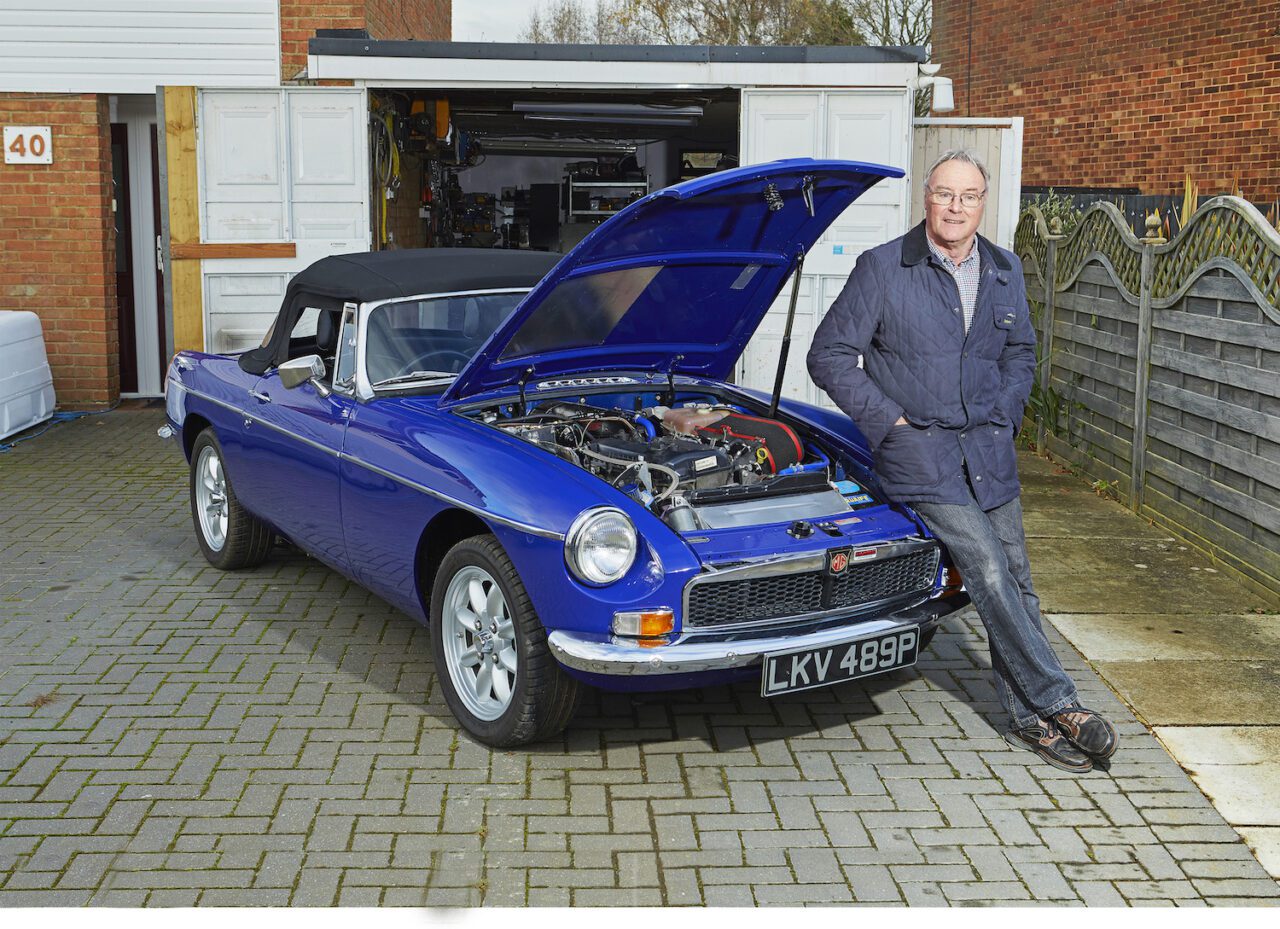
Fresh from the pages of Practical Classics Magazine, we meet Trevor Smith, who went down a modern route to converting his MGB engine, and Jim Smyth, who has been converting his Fiat 1500 for the last 31 years.
As a specialist classic car insurance broker, we love seeing old cars being restored to their former glory, which is why we’ve linked up with Practical Classics to bring you two fantastic stories each month for you to digest and take as inspiration for your own classic rebuilds.
The 1975 MGB Roadster modern engine conversion
Words by Matt George and Pictures by Matt Howell
Trevor Smith decided to go down a much more modern route than your conventional MGB engine conversion.
Dropping a Rover V8 into an MGB shell is a well-trodden route to achieving more power than the original B-series motor can provide. But while planning his own conversion, Trevor Smith concluded he could come up with something a little bit better.
“My original idea was to go down the Rover V8 route, but after doing some research, it seemed like a lot of work for what would be a lovely sound but only 137bhp and a basic gearbox. A casual remark by my son about using a Ford Duratec engine got me thinking. I again did some research and found it was quite easy to achieve 180bhp with a standard 2-litre engine, and because this engine is also used in the rear-wheel-drive Mazda MX-5 MkIII, a modern five- or six-speed gearbox could be used.”
As a retired engineer, it was then that the habits of a lifetime kicked in for Trevor. “I thought that it would be a good challenge to create a classic MGB with modern powertrain and suspension. This would be a classic car with modern day performance, fuel economy and reliability.”
To add to the challenge, Trevor decided he would complete this upgrade without cutting, welding, or modifying the MGB. He would achieve this by designing new engine mountings, modifying the front crossmember, modifying the gearbox crossmember and making a one-piece machined adaptor to connect the Mazda propshaft to the MGB rear axle. Even the exhaust would be mounted, utilising the original MGB fixing positions and the gear-lever in the same position as the MGB. “I thought that other people might like to achieve this upgrade as a simple nut and bolt procedure,” says Trevor.
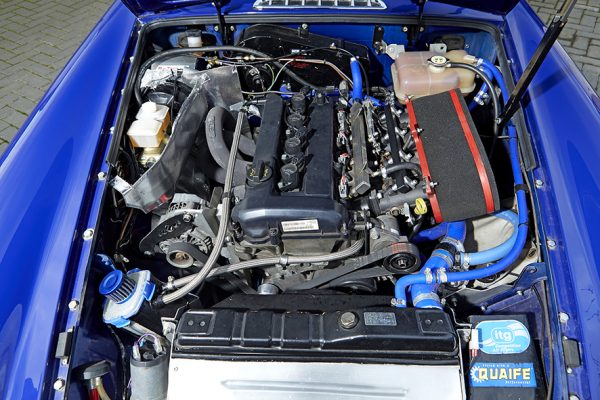
Trevor originally used a 2-litre Duratec engine from a Mazda MX-5 MkIII. “It was my intention to achieve 200bhp with 174 foot pounds of torque, achievable without any changes to this engine, except for having a good induction system and a competition exhaust system – four into two into one. He even had a name for his planned creation: MG B-Tec 200.
“I chose this engine because it had variable valve timing and 173bhp as standard, making it very feasible to achieve my 200bhp target”. The fully rebuilt Mazda engine was installed into the car. But it wasn’t all plain sailing.
“After two visits to the rolling road, we could not get the engine to run as Troy would have liked, and each time not wanting to stress the newly built engine, we aborted the mapping process. The exhaust primaries were not all at the same temperature, cylinders one and three were not getting as hot as they should.”
Fault finding by the normal way of changing components was not an option because it could have been the MBE ECU, custom wiring loom, throttle bodies or the map itself. “None of these components are cheap to change, and as I had already spent over £1,000 at the rolling road, and subsequent diagnostics, I decided to take out the Mazda engine and install a running Ford ST150 Duratec unit to prove if there was a fault with the Mazda engine or not.”
On the third visit to the rolling road, it did seem that there could still be a problem with cylinders one and three. A strip down of the throttle bodies and inlet manifold followed, taking extra care on sealing interfaces. The fourth visit did allow full mapping of the engine, and it has remained in the car. The downside of this, apart from the extra cost of going to the rolling road four times, is the starting point was only 150bhp, so the final figure for this engine is 173bhp with 143ft⋅lbs of torque, short of the 200bhp target.
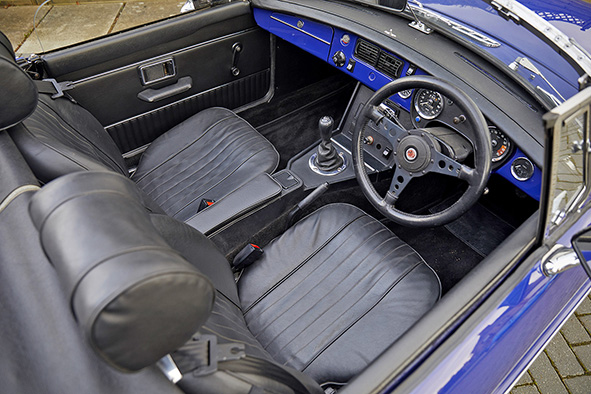
The MGB gearbox was substituted with an MX-5 MkIII six-speed unit and propshaft, taken from a 2007 car, which correlates to the Duratec engine. To have the best chance of retaining the original balance of the MGB’s handling and allow the handling and ride to be adjustable, adjustable shock absorbers with parabolic springs were used on the rear, and coil over adjustable shock absorbers were used on the front. Trevor had done his engineering homework, too.
“Using the lighter engine and virtually doubling the power output over the original 95bhp B-series engine, the ‘roll couple’ (amount of weight transfer when cornering) between the front and rear suspension was compromised. Power oversteer would be a problem, the car would want to go backwards through a hedge at every opportunity. To get more weight transfer onto the front suspension, I lowered the roll centre height by designing a double wishbone front suspension setup, utilising a coil-over damper.”
By utilising custom-made engine mountings and crossmembers to substitute the Duratec/Mazda engine/gearbox unit with the standard MGB unit and using the MGB unmodified mounting points, Trevor found that it was relatively straightforward to get all the newer components all working together properly in an older car.
“My only concern was that to have the gear lever end up in the same position as the MGB gearbox, would the rear water take off port on the back of the engine foul the bulkhead? Thankfully it doesn’t. I chose to use a MGB V8 radiator as it is the correct width and gives additional cooling capacity, but this is currently too efficient, and I am looking at getting the engine to run hotter.”
The body looked very solid, but when the front wings, doors, boot lid and bonnet were removed and blasted, it was considered the front and rear wings were not good enough to use, so new ones were fitted. The same with both floor panels, so again two new full-length floor panels were fitted. The complete car then had a full back-to-metal procedure, this was the complete underneath and engine bay, but excluded the boot. No welding was required to any other parts of the chassis.
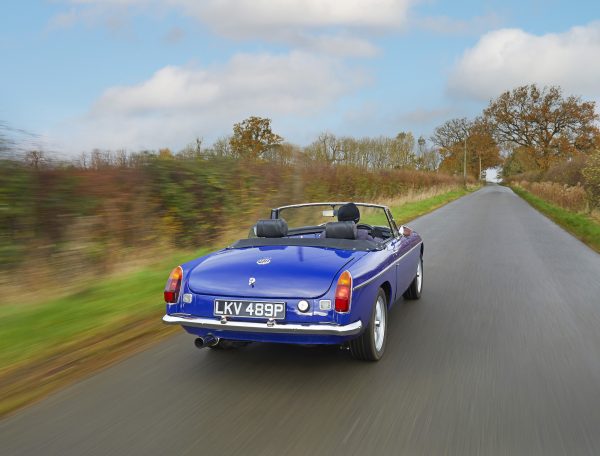
From the outset, Trevor wanted the car to look every part the classic MGB, so he kept the interior standard, except the dashboard, which was sprayed the same colour as the bodywork.
Due to Trevor’s engineering and motorsport background, the design of bespoke components to ensure that no cutting or welding was required to the original MGB, was very satisfying for him. “Due to the change to weight distribution, the suspension design/modifications and traction upgrades, the result is a well-balanced handling car, where the increased power output can be fully appreciated. Overall, it is very enjoyable that I now have a lovely, fully restored classic MGB Roadster with all the benefits of modern mechanicals.”
It turns heads on the road, too. “I must also confess that seeing the expression on other drivers’ faces who have witnessed a turn of speed from an old classic MGB is enjoyable. But overall, the driving experience makes all the work and initial frustrations very much worth it.”
Read the full version of how Trevor managed to give his 1975 MGB a modern engine conversion on the Practical Classics page.
It took Jim Smyth three decades to finish his Fiat 1500, but it was worth it
Interview by Danny Hopkins and Pictures by Laurens Parson
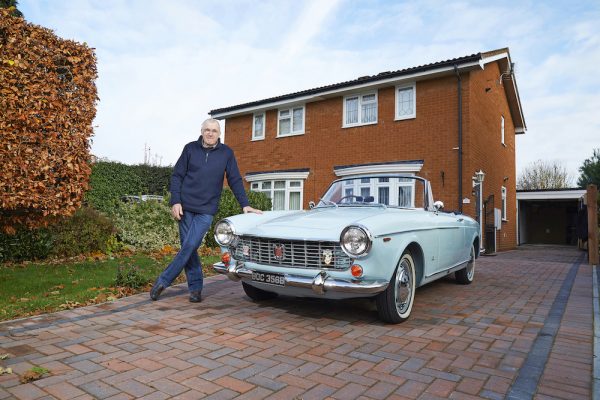
It had been 31 years since Jim Smyth dragged his old Fiat out of a scrapyard and up until last year, he had never driven it.
Even then, things weren’t exactly straightforward as the first test drive was terrible. It was all over the place! It certainly needed some fine tuning, but, after all that time had passed, it was 2021 and he was just happy to be carrying out the shake-down tests at long last. Here he recalls his story of finally getting his Fiat on the road.
“I bought the car in 1990 from a salvage yard, where it had been left in a very sorry state indeed. I probably should have left it, but there was something about the car that caught my eye. The 1300 and 1500 were a series of nicely engineered saloons and estates made in the 60s but the Pininfarina-styled Cabriolet was a cut above, plus it had disc brakes and a five-speed gearbox.
“I have to admit, I’d never clapped eyes on one until I found mine! I had owned classics before this one, including a Humber Sceptre, Ford Anglia, Zephyr 6 and various minivans and pickups, but I just really fell for the lines of the Fiat when I saw it, despite the poor condition. The car had been dumped in the corner of the scrap yard, along with another one, so I paid £780 for the two.
“Once I got them home, closer inspection revealed the horrible truth. The ‘spares’ car was a 1961 1200, which had initially looked to be a better example. Sadly though, it had been shot-blasted very poorly, with every panel badly distorted. So I stripped it completely, removing all the useful parts and scrapped the shell – unthinkable nowadays, but this was 1990 after all.
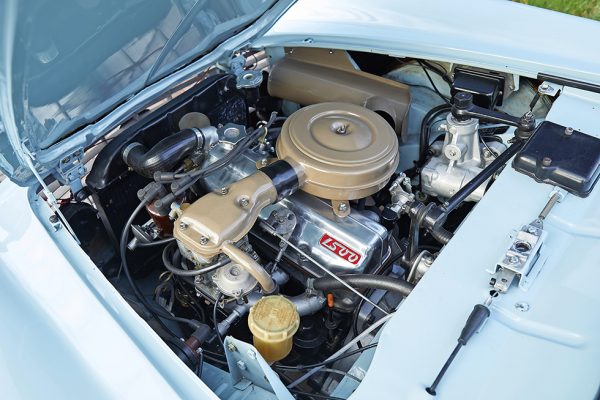
“Turning my attention to the 1963 car, I reckoned it would be a two-year restoration so set about preparing it. I didn’t just want to patch it up and get it running – I wanted to do it properly.
“The corrosion was pretty bad. The back end had rotted, including the rear arches, while the doors and bonnet were rusty too. I think, as a whole, about 70% of it was rust! During the course of the next few years, I walked away several times, but it was always my intention to get it back on the road. There was never any question of that.
“As a former welder and fabricator for a construction firm, I’d learned a lot over the years and I later had my own MOT station (which I’ve since passed onto my son). I was quite confident in what I was doing, but one day, for whatever reason, I tucked it away and before I knew it, another decade had passed. Life has a habit of getting in the way, but the turning point came in recent years, when my wife Liz passed away.
“After such a life-changing moment, I became even more determined to get the car finished and so I got going with it again, thanks in part to a great deal of patience from my sons Sheridan and Courtney. This time, I did a lot of the work at home in my garage and have some space at the back where I can do a lot of the detailed jobs.
“There were some complications, partly thanks to Fiat! The company never officially sold these cars in the UK so they were all left hand drive. However, some dealers decided to give it a go, using steering boxes and other parts from right hand drive saloons. There’s even an official plate under the bonnet as proof. However, it wasn’t a good job and I’ve had to improve the whole thing!
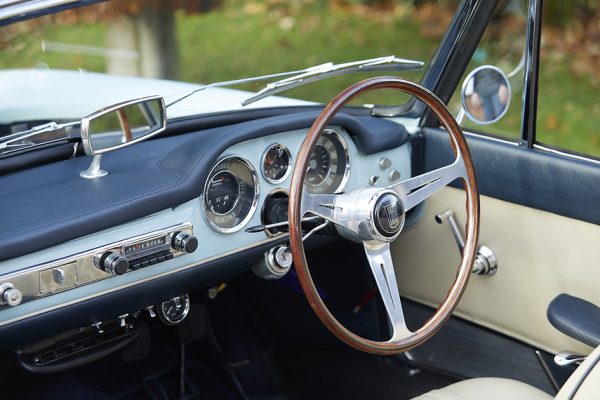
“They chopped up and reconfigured the dashboard – very Heath Robinson. I had to carry out a lot of repairs to improve it. Where they’d plated bits of the dash, I needed to cut out the rot and weld it all back together. Once that was sorted, my friend Dave Low helped me with the dash trim and the seats, too. It’s almost identical in colour to the original seat upholstery. Me and my mate Fred then spent a few days stripping two wiring looms to make one good loom.
“The engine is a 1500 crossflow, which I rebuilt. I got some standard pistons I picked up from a local firm. The crank was good, so all I had to do was hone it out, re-gasket everything, and put it all back together.
“I haven’t stopped grinning since. I displayed it at the NEC Classic Motor Show in 2021 and it attracted a lot of attention. MGBs are great as you can buy everything for those but I like more of a challenge. It might take you a bit longer to restore, like 31 years for instance, but it is always worth it in the end!”
Read the full version of how Jim converted his Fiat 1500 on the Practical Classics page.
Practical Classics: Perfect reading for classic car and restoration enthusiasts
The Restorer of the Year competition is one you certainly won’t want to miss. Each magazine edition features two unique stories on how classic car owners have managed to restore beautiful classics they have found to working order. The winner will be chosen by the readers and will be revealed at the NEC’s Classic Car & Restoration Show in March 2023.







